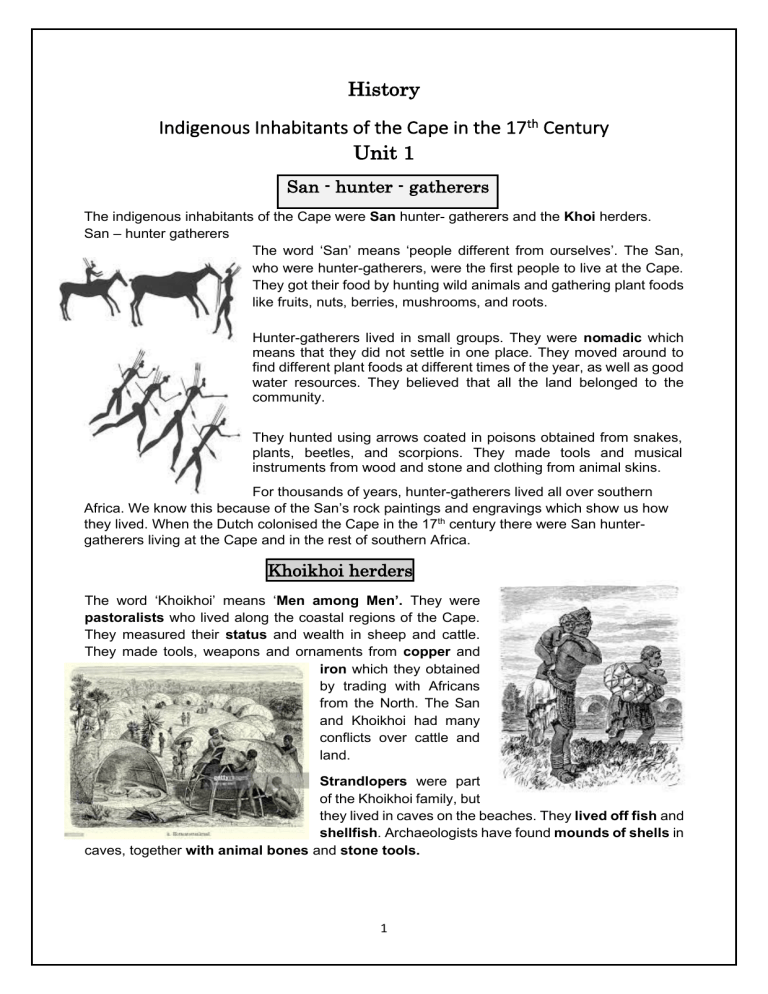
History Indigenous Inhabitants of the Cape in the 17th Century Unit 1 San - hunter - gatherers The indigenous inhabitants of the Cape were San hunter- gatherers and the Khoi herders. San – hunter gatherers The word ‘San’ means ‘people different from ourselves’. The San, who were hunter-gatherers, were the first people to live at the Cape. They got their food by hunting wild animals and gathering plant foods like fruits, nuts, berries, mushrooms, and roots. Hunter-gatherers lived in small groups. They were nomadic which means that they did not settle in one place. They moved around to find different plant foods at different times of the year, as well as good water resources. They believed that all the land belonged to the community. They hunted using arrows coated in poisons obtained from snakes, plants, beetles, and scorpions. They made tools and musical instruments from wood and stone and clothing from animal skins. For thousands of years, hunter-gatherers lived all over southern Africa. We know this because of the San’s rock paintings and engravings which show us how they lived. When the Dutch colonised the Cape in the 17th century there were San huntergatherers living at the Cape and in the rest of southern Africa. Khoikhoi herders The word ‘Khoikhoi’ means ‘Men among Men’. They were pastoralists who lived along the coastal regions of the Cape. They measured their status and wealth in sheep and cattle. They made tools, weapons and ornaments from copper and iron which they obtained by trading with Africans from the North. The San and Khoikhoi had many conflicts over cattle and land. Strandlopers were part of the Khoikhoi family, but they lived in caves on the beaches. They lived off fish and shellfish. Archaeologists have found mounds of shells in caves, together with animal bones and stone tools. 1 ACTIVITY 1 USE P. 155 AND 156 IN YOUR TEXTBOOK TO ANSWER THE FOLLOWING QUESTIONS: 1. What is the flat – topped mountain in the painting in Source A called? 2. Which 2 countries’ flags are the ships in the bay flying? 3. What can you see on the land between the mountain and the sea? 4. How do you know that this picture was not painted before 1652? 5. In which provinces have the remains of the Khoikhoi camps been found? 6. In which provinces did the San live? 7. What were the Khoikhoi who lived from the sea called? 8. Explain why land was so important to the indigenous people? 9. Complete the following sentence: ‘The San ate wild animals, berries…’ 10. How do we know the San were creative people? 11. What have archaeologists dug up that taught us about the Strandlopers? 12. Give the definitions of the following terms: Huntergatherers Rock paintings Engravings Livestock Unit 2 Where African farmers were settled The Xhosa tribes came from Central Africa and settled in the Eastern Cape where the Transkei and Ciskei are today. African farmers planted and ate sorghum and millet. This region was suitable for their crops as it received about 500mm of rain during the summer growing season. . African farmers also owned large herds of cattle. Farmers built stronger, more permanent houses than the San and Khoi because they usually stayed in one place for a few years. They used mainly wood, reeds, and grass to make houses. ACTIVITY 2 P. 159, QUESTIONS AND ANSWERS 2


